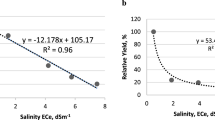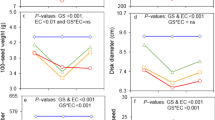Summary
The effect of irrigation interval on the relationship between yield and the salt concentration of irrigation water salinity was studied on eggplant (Solanum melongena L.) in 5 × 6 m plots irrigated by a trickle irrigation system. Three levels of irrigation water salinity, having electrical conductivities of 1.5, 4.5 and 10.0 dS · m−1, and five irrigation intervals (2, 5, 8, 12 and 16 days) were applied.
A regression of yield (Y), expressed in units of kg · m−2, on soil salinity, expressed in dS · m−1 as the saturation extract electrical conductivity (EC e ) averaged for the 0–0.9 m depth at the end of the experiment was: Y 2–12= 20.8–1.28 (EC e ); r=0.94 for irrigation intervals of 2 to 12 days. For the 16 day irrigation interval the regression equation was Y 16=17.3-1.13 (EC e ); r=0.82. Up to 12 days the length of the irrigation intervals had no interactive effect on the relationship between yield and salinity. For the 16 day irrigation interval, relative yield reduction was similar (about 17%) at all levels of salinity. A 50% reduction in yield was obtained at EC e =8.5 dS · m−1 for both the short and long intervals. Increasing the irrigation frequency from that used under nonsaline conditions did not change the relationship of relative eggplant yield to salinity.
With increasing salinity and increasing irrigation interval, individual fruit weight decreased but the percentage of marketable fruit increased to the extent that the quantity of marketable fruit was not affected by either factor (Table 2). Stomatal diffusion conductance was not affected by either salinity or interval, and was about 0.3 cm s−1. Leaf water potential, on the other hand, decreased with the decrease in soil water potential, due to increase in either soil water suction or solute concentration. The reduction in leaf water potential correlated with yield reduction. CO2 fixation rate per unit leaf area increased by 35–45% as salinity increased, but decreased by 54–58% as the irrigation interval increased (Table 6).
Similar content being viewed by others
References
Ayers AD, Wadleigh CH, Magistad OC (1943) The interrelationship of salt concentration and soil moisture content with the growth of beans. J Am Soc Agron 35:796
Ayoub Ali T (1977) Some primary features of salt tolerance in Senna (Cassia acutifolia). J Exp Bot 28:484
Bernstein L, Francois LE (1973) Leaching requirement studies: Sensitivity of alfalfa to salinity of irrigation and drainage waters. Proc Soil Sci Soc Am 37:931
Bernstein L, Francois LE (1975) Effect of frequency of sprinkling with saline waters compared with daily drip irrigation. Agron J 67:185
Bielorai H, Levy Y (1971) Irrigation regimes in a semi-arid area and their effect on grapefruit yield, water use and soil salinity. Israel J Agric Res 21:3
Bielorai H, Shalhevet J, Levy Y (1978) Grapefruit response to variable salinity in irrigation water and soil. Irrig Sci 1:61
Heuer Bruria, Plant Z (1981) Carbon dioxide fixation and RuBP carboxylase activity in intact leaves of sugar beet plants exposed to salinity and water stress. Ann Bot 48:261
Meiri A, Kamburov Josephine, Shalhevet J (1977) Transpiration effects on anticipated leaching fractions. Agron J 69:779
Rawlins SL, Raats PAC (1975) Prospects for high frequency irrigation. Science 88:604
Scholander PF, Hammel HT, Bradstreet ED and Hemmingsen EA (1965) Sap pressure in vascular plants. Science 148:339
Schwarz M, Gale J (1981) Maintenance respiration and carbon balance. J Exp Bot 32:933
Shalhevet J. Bernstein L (1967) Effect of vertically heterogeneous soil salinity on plant growth and water uptake. Soil Sci 106:85
Shalhevet J, Reiniger P, Shimshi D (1969) Peanuts response to uniform and nonuniform soil salinity. Agron J 61:384
Shimshi D (1969) A rapid field method for measuring photosynthesis with labelled carbon dioxide. J Exp Bot 20:381
Shimshi D, Livne A (1967) The estimation of osmotic potential of plant sap by refractometry and conductometry: a field method. Ann Bot 31:505
Wadleigh CH (1945) The integrated soil moisture stress upon a root system in a large container of saline soil. Soil Sci 61:225
Wadleigh CH, Ayers AFD (1945) Growth and biochemical composition of bean plants as conditioned by soil moisture tension and salt concentration. Plant Physiol 20:106
Wadleigh CH, Gauch HG, Magistad OC (1946) Growth and Rubber Accumulation in Guayule as Conditioned by Soil Salinity and Irrigation Regime. USDA Tech Bul US Dept Agric 925:34
Author information
Authors and Affiliations
Additional information
Contribution from the Agricultural Research Organization, No. 572-E, 1982 series This research was supported by a grant from the United States-Israel (Binational) Agricultural Research and Development Fund (BARD)
Rights and permissions
About this article
Cite this article
Shalhevet, J., Heuer, B. & Meiri, A. Irrigation interval as a factor in the salt tolerance of eggplant. Irrig Sci 4, 83–93 (1983). https://doi.org/10.1007/BF00273377
Received:
Issue Date:
DOI: https://doi.org/10.1007/BF00273377




